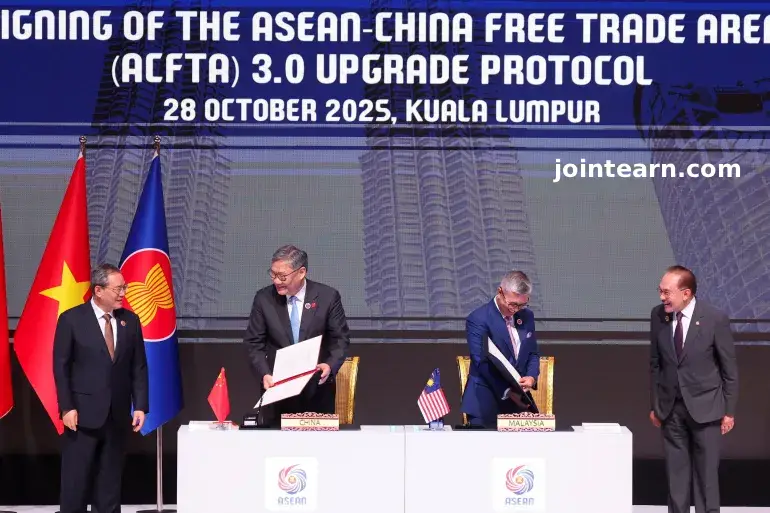
Kuala Lumpur, Malaysia – October 28, 2025 — In a significant move aimed at deepening regional integration and countering the effects of the United States’ escalating tariffs, China and the Association of Southeast Asian Nations (ASEAN) have signed an upgraded version of their long-standing free trade agreement. The ASEAN-China Free Trade Area (ACFTA) 3.0 Upgrade Protocol marks a new phase of economic cooperation between Beijing and the 11-member Southeast Asian bloc.
The agreement was signed on the sidelines of the 47th ASEAN Summit in Kuala Lumpur, witnessed by Chinese Premier Li Qiang and Malaysian Prime Minister Anwar Ibrahim, underscoring the growing strategic and economic partnership between China and Southeast Asia.
What the ASEAN–China Free Trade Area 3.0 Upgrade Means
The “3.0 version” of the ASEAN-China Free Trade Agreement (ACFTA) expands cooperation beyond traditional trade in goods. According to China’s State Council, the enhanced pact emphasizes digital economy integration, green transition, sustainable infrastructure, supply chain resilience, and people-to-people connectivity.
Building on the original agreement first enacted in 2010, this upgraded framework aims to modernize trade mechanisms and align with global digital transformation trends.
Premier Li Qiang highlighted that the upgraded agreement represents a shared commitment to “expanded and higher-quality economic cooperation.” He praised ASEAN governments for strengthening collaboration even as global trade faces turbulence from protectionist measures.
China and ASEAN: Growing Trade Partners in a Shifting Global Economy
Trade between China and ASEAN continues to surge, reaching $785 billion in the first nine months of 2025 — a 9.6 percent year-on-year increase. Much of this growth is driven by integrated supply chains under the “China Plus One” strategy, which encourages companies to diversify production across Southeast Asia while maintaining links to China’s manufacturing ecosystem.
This deep economic interdependence has made China and ASEAN each other’s largest trading partners, a milestone achieved amid shifting global trade dynamics and Washington’s tariff-heavy approach under US President Donald Trump.
Expert Perspectives: A “Win-Win” Amid US Tariff Pressures
According to Zhiwu Chen, Professor of Finance at the University of Hong Kong, the new free trade pact comes at a pivotal moment for Beijing.
“This is very important for China, as its trade tensions with the US and EU have been rising,” Chen told Al Jazeera. “China needs ASEAN countries, and ASEAN, in turn, can leverage this window of opportunity to attract investment and technology. It’s a clear win-win outcome for both sides.”
The agreement signals Beijing’s intent to strengthen its economic diplomacy in the Asia-Pacific region, ensuring that ASEAN remains a central hub in its Belt and Road Initiative (BRI) and broader trade diversification strategy.
Trump’s Tariffs and the Push for Regional Resilience
Premier Li’s remarks at the summit included a sharp critique of the United States’ unilateral trade policies, particularly the tariff regime introduced by the Trump administration.
“Unilateralism and protectionism have seriously disrupted the global economic and trade order,” Li said. “External forces are increasingly interfering in our region, and many countries have been unfairly subjected to high tariffs.”
Since the beginning of 2025, President Trump has reintroduced or increased tariffs on multiple Chinese exports, citing national security and trade imbalances. Earlier this month, he threatened to impose a 100 percent tariff on Chinese goods starting November 1, following Beijing’s decision to tighten export controls on rare earth minerals — key components in electronics and renewable technologies.
However, US Treasury Secretary Scott Bessent later confirmed that Washington and Beijing had reached a “framework agreement” to de-escalate the tariff dispute, potentially averting an all-out trade war.
ASEAN’s Strategic Position Between Two Giants
While ASEAN nations are eager to benefit from Chinese investment and supply chain expansion, many also continue to engage with the US through bilateral trade agreements. During the same summit, President Trump signed new trade deals with Cambodia and Malaysia, and established framework agreements with Thailand and Vietnam, reaffirming his preference for one-on-one negotiations over multilateral pacts.
The new deals reportedly finalize the so-called “reciprocal tariff rate” for these four nations, set between 19 and 20 percent. Analysts say this move reflects Trump’s continued effort to reshape US trade relationships in the Indo-Pacific, even as it pushes ASEAN closer to China economically.
Economic Outlook: Cooperation Amid Competition
Despite global headwinds, analysts believe the ACFTA 3.0 upgrade will further stabilize regional trade and attract cross-border investments in technology, clean energy, and logistics.
The agreement’s focus on digital trade, sustainable manufacturing, and customs modernization aligns with ASEAN’s long-term goal of creating a more integrated regional market capable of competing with the EU and North America.
As Malaysia’s Prime Minister Anwar Ibrahim noted during the signing ceremony, “The upgraded ASEAN-China Free Trade Area demonstrates our shared vision for an open, inclusive, and sustainable regional economy — one that benefits all our peoples.”
Summary of Key Developments
- Event: Signing of ASEAN–China Free Trade Area (ACFTA) 3.0 Upgrade Protocol
- Date: October 28, 2025
- Venue: 47th ASEAN Summit, Kuala Lumpur, Malaysia
- Witnessed by: Chinese Premier Li Qiang & Malaysian Prime Minister Anwar Ibrahim
- Focus Areas: Digital trade, green economy, infrastructure, and trade facilitation
- Trade Volume (Jan–Sept 2025): $785 billion (+9.6% YoY)
- Context: Upgraded pact follows new US tariffs under President Donald Trump


Leave a Reply